The Intel Core i3-7350K (60W) Review: Almost a Core i7-2600K
by Ian Cutress on February 3, 2017 8:00 AM ESTLegacy and Synthetic Tests
At AnandTech, I’ve taken somewhat of a dim view to pure synthetic tests, as they fail to be relatable. Nonetheless, our benchmark database spans to a time when that is all we had! We take a few of these tests for a pin with the latest hardware.
Cinebench R10
The R10 version of Cinebench is one of our oldest benchmarks, with data going back more than a few generations. The benchmark is similar to that of the newest R15 version, albeit with a simpler render target and a different strategy for multithreading.
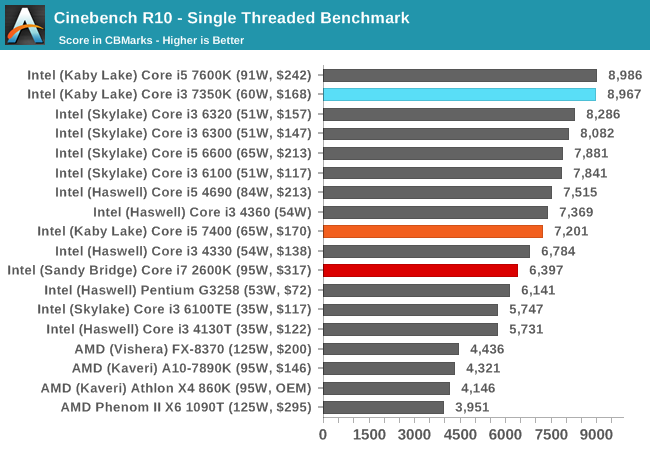
With high frequency in tow, the Core i3-7350K makes its mark.
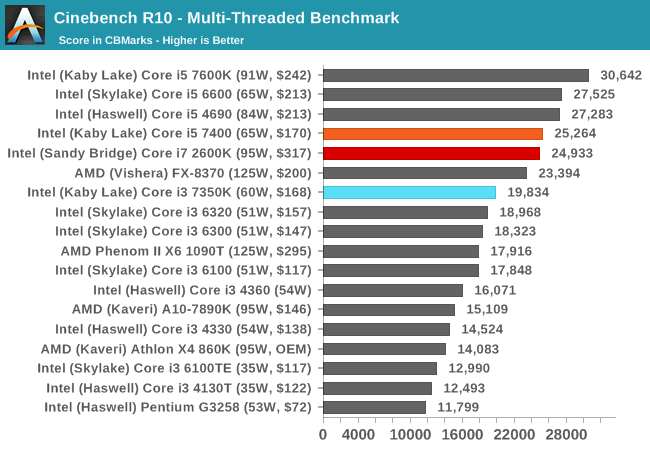
When more threads come to play, the Core i5-7400 and Core i7-2600K battle it out in terms of four cores and IPC vs hyperthreading. The Core i3-7350K sits around ~25% behind.
Cinebench R11.5
CB11.5 has been popular for many years as a performance test, using easy to read and compare numbers that aren’t in the 1000s. We run the benchmark in an automated fashion three times in single-thread and multi-thread mode and take the average of the results.
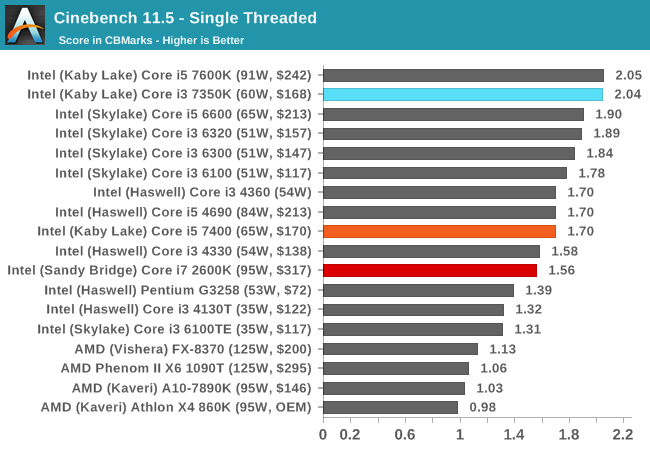
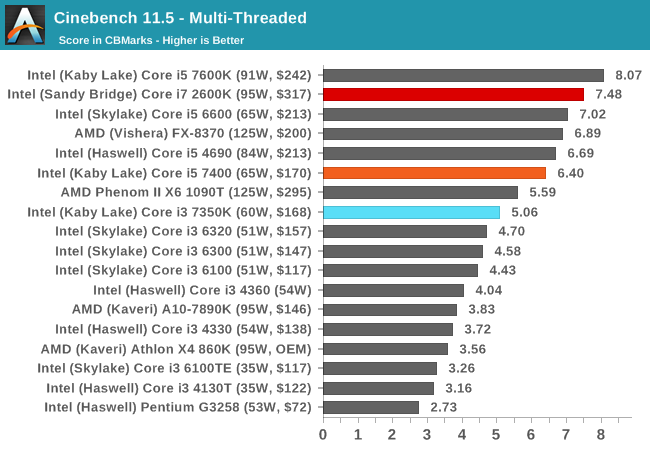
Similar to CB10, the single thread results show that a 4.2 GHz Kaby Lake is nothing to be sniffed at. In the multithreaded test, CB11.5 is more able to leverage the hyperthreads, showing that a Core i7-2600K will run rings around the low end Kaby i5, but is bested by the higher frequency Kaby i5-K. The Core i3 still has that dual core deficit.
7-zip
As an open source compression/decompression tool, 7-zip is easy to test and features a built-in benchmark to measure performance. As a utility, similar to WinRAR, high thread counts, frequency and UPC typically win the day here.
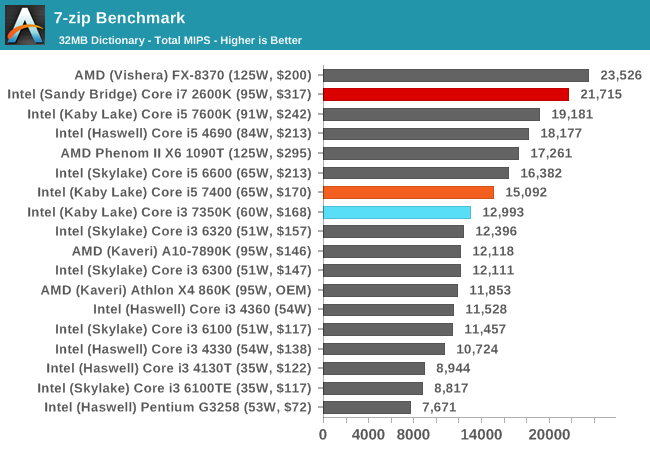
The difference between the i3-7350K and the i5-7400 shows that 7-zip prefers cores over threads, but the Core i7-2600K results show it can use both to good effect, even on older microarchitectures, scoring almost double the i3-7350K.
POV-Ray
Ray-tracing is a typical multithreaded test, with each ray being a potential thread in its own right ensuring that a workload can scale in complexity easily. This lends itself to cores, frequency and IPC: the more, the better.

POV-Ray is a benchmark that is usually touted as liking high IPC, high frequency and more threads. The i7-2600K, despite having double the resources of the Core i3-7350K, is only 30% ahead.
AES via TrueCrypt
Despite TrueCrypt no longer being maintained, the final version incorporates a good test to measure different encryption methodologies as well as encryption combinations. When TrueCrypt was in full swing, the introduction of AES accelerated hardware dialed the performance up a notch, however most of the processors (save the Pentiums/Celerons) now support this and get good speed. The built-in TrueCrypt test does a mass encryption on in-memory data, giving results in GB/s.
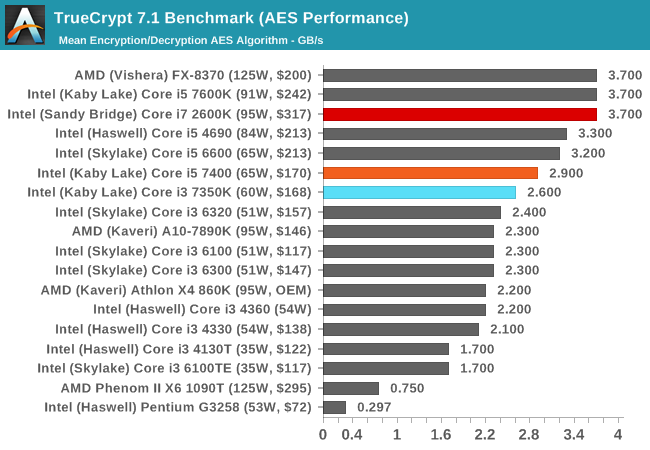










186 Comments
View All Comments
eldakka - Sunday, February 5, 2017 - link
"celeron - duel core"Calm down, breathe. It's not something worth dueling over!
AndrewJacksonZA - Monday, February 6, 2017 - link
Yeah eldakke, "duel" vs "dual" is also something that gets my heart rate up. :-)Old_Fogie_Late_Bloomer - Monday, February 6, 2017 - link
Username checks outAssBall - Friday, February 17, 2017 - link
Duel core? Funny mine never got into a fight.....R0H1T - Friday, February 3, 2017 - link
Yeah that's true except when people find out that there's this thing called Ryzen just on the horizon. Seems to me that the HT pentium & unlocked is just a way to sell more of these KL chips & Intel are hoping/waiting for Coffee Lake to counter Zen.There's no way a dual core is justified today, even if unlocked or with HT, unless you're absolutely on a shoestring of a budget &/or KL is the only thing you want. It's such bad value for money atm that no one should be recommending it, not at this point in time.
lopri - Sunday, February 5, 2017 - link
I have to agree. Not necessarily because there is anything wrong with this chip technically but because of the competitive landscape where Intel's own quad-core chips can be had for the same or lower prices.Meteor2 - Sunday, February 5, 2017 - link
I think the only thing which can be recommended at the moment is not to buy a CPU until Zen is released, in case AMD live up to their hype in performance and price their products competitively (I.e. cheaper than Intel).bananaforscale - Wednesday, February 8, 2017 - link
And see how Intel reacts. Gimme a 20% price drop on hex cores!Jumangi - Saturday, February 4, 2017 - link
They would be misleading gamers badly as is this Anandtech review. Their gaming becnhmarks are just woefully out of date its getting embarassing. There are already games that have come out like Farcry 4 that literally won't run if the system doesn't have 4 full cores. Any real gamer is screwing themselves over by trying to skimp on a CPU like this. Any legit tech site would never reccomend less than a 4 core CPU in 2017.Meteor2 - Sunday, February 5, 2017 - link
@nathanandrews hasn't that always been the case? Except, you might not be able to afford an i7, and (as these results show) you're better buying an i5 and a better GPU for gaming.